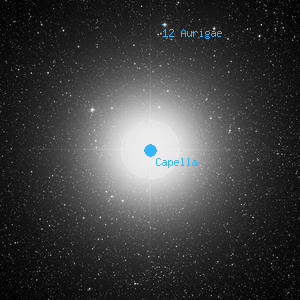Capella

Overlaid DSS image of Capella, 60' x 60' with north at top and west to the right
Aladin viewer for the region around Capella
Hōkūlei, Alpha Aurigae, α Aur, 13 Aur
BD+45 1077, HD 34029, HR 1708, WDS J05167+4600, SAO 40186, HIP 24608
BD+45 1077, HD 34029, HR 1708, WDS J05167+4600, SAO 40186, HIP 24608
| Type | Star |
|---|---|
| Magnitude | 0.08 | Right Ascension | 5h 16' 41.4" (2000) |
| Declination | 45° 59' 53" N |
| Constellation | Auriga |
| Classification | G3III: |
Observing Notes
Andrew Cooper
Feb 19, 2020 Waikoloa, HI (map)
20cm f/6 Newtonian, Cave Astrola @ 61x
Seeing: 7 Transparency: 6 Moon: 0%
Gold, very bright, no companion noted
Andrew Cooper
Jan 31, 2020 Waikoloa, HI (map)
20cm f/6 Newtonian, Cave Astrola @ 76x
Seeing: 7 Transparency: 6 Moon: 0%
Brilliant yellow-orange, no companion noted, non-visual binary
Captain William Henry Smyth
Oct 9, 1831 No. 6 The Crescent, Bedford, England (map)
150mm f/17.6 refractor by Tully 1827
A standard Greenwich star, with two distant companions, on the right shoulder-blade of Auriga. A 1, bright white; B 12, pale blue; C 9, grey; AB being 30 ♅. VI., and AC No. 51 of H. and S., under these measures:♅. Pos. 151°23' Dist. 169".0 Ep. 1780.69Here the principal star is Capella, a name considered to allude to the goat and kids, which Auriga, the waggoner, has charge of; but it is sometimes called el-'áyyúk, a word of doubtful origin and signification. The Arabs distinctly termed it the Guardian of the Pleiades; and many astronomers treated it as a single constellation, under the name of Hircus, or Capra, the goat. Capella is a brilliant object, and as it never sets at Bedford, and my view was unobstructed, it described a noble circle, of which both the upper and lower transits used to be taken.
H. and S. 348°02' 454".2 1821.22
This is one of those stars which Piazzi attacked with the intention of detecting parallax, as detailed in the Memoirs of the Italian Society. Sir William Herschel measured its diameter, and concluded it to be 2".5. Sir John Herschel says, "I have a strong impression that Capella, within my recollection, has increased in brightness. M. Struve is of the same opinion." Its proper motions in space have been valued as follows:P.... RA +0".12 Dec. -0".44Auriga is one of the original forty-eight asterisms, though it has gone by divers other denominations, as Heniochus, Myrtillus, Elasippus, and Erichthonius. It is thought to have been the Horus of the Egyptians; but there is a want of apparent connection between the goat, kids, and carter, and the potent son of Isis. The Arabians drew a mule, instead of the human form; but they knew the latter figure also, and called it Mumsiki-l a' inan, or holder of the reins. It has been thus tabulated:
B.... +0".20 -0".41
A.... +0".14 -0".43
[Hipparcos +0".07525 -0".42689]Ptolemy . . . 14 stars Bullialdus. . . . 27 starsThe goat in this constellation has been recognised as Amalthæa, the nurse of Jupiter, and mother of the Εριφοι, Hædi, or two stars ζ and η in the arm of Auriga, emphatically termed "horrida et insana sydera:" with a third star they form an isosceles triangle, ζ and η were termed al-'anz, the goat, by the Arabians, and the former was Dhât-al-'inán, corrupted to Sadatoni in the Alphonsine Tables. The Hædi were regarded by mariners of yore, as affording presages of the weather: and they were so much dreaded, that they are said to have closed navigation at their rising. Hence, in an Epigram of the Anthologia, Callimachus says :
Ulugh Beigh . . 13 Hevelius . . . . 40
Tycho Brahé . . 27 Flamsteed . . . 66
Bayer . . . 32 Bode . . . . . 239Tempt not the winds, forewarned of dangers nigh,When the day of their peculiar influence was passed, a festival with sports and games was celebrated, under the denomination of Natalis Navigationis. Even Germanicus calls them unfriendly stars to seamen, nautis inimicum sydus in undis. In the early and well-known Venetian illustrations to Hyginus, Heniochus is delineated in a car drawn hy two oxen and two horses, with a goat on his right shoulder, and two kids on his right hand: "In manu duas quse Hædi appellantur stellis prope occidentibus formati."
When the Kids glitter in the western sky.
Capella, the shepherd's star, is a brilliant insulated object, and therefore of easy alignment. A line drawn from Polaris perpendicular to the line of the Pointers, and on the opposite side to Ursa Major, passes, at 44° distance, through it. It will also be found by a ray projected through α and δ, the two most northern stars of the Great Bear's body, into the irregular pentagon formed by Auriga. If looking from the southward for it, take the rhymester's advice:From Rigel rise, and lead a line,
through Bellatrix's light,
Pass Nath, upon the Bull's north horn,
and gain Capella's height
Where a large triangle is form'd
(isosceles it seems),
When beta is with delta join'd
to lustrous alpha's beams.― A Cycle of Celestial Objects Vol II, The Bedford Catalogue, William Henry Smyth, 1844
Other Data Sources for Capella
Nearby objects for Capella
4 objects found within 120'
| 12 Aurigae | Berkeley 18 | |
| NGC 1798 |
Credits...
Drawings, descriptions, and CCD photos are copyright Andrew Cooper unless otherwise noted, no usage without permission.
A complete list of credits and sources can be found on the about page
Capella